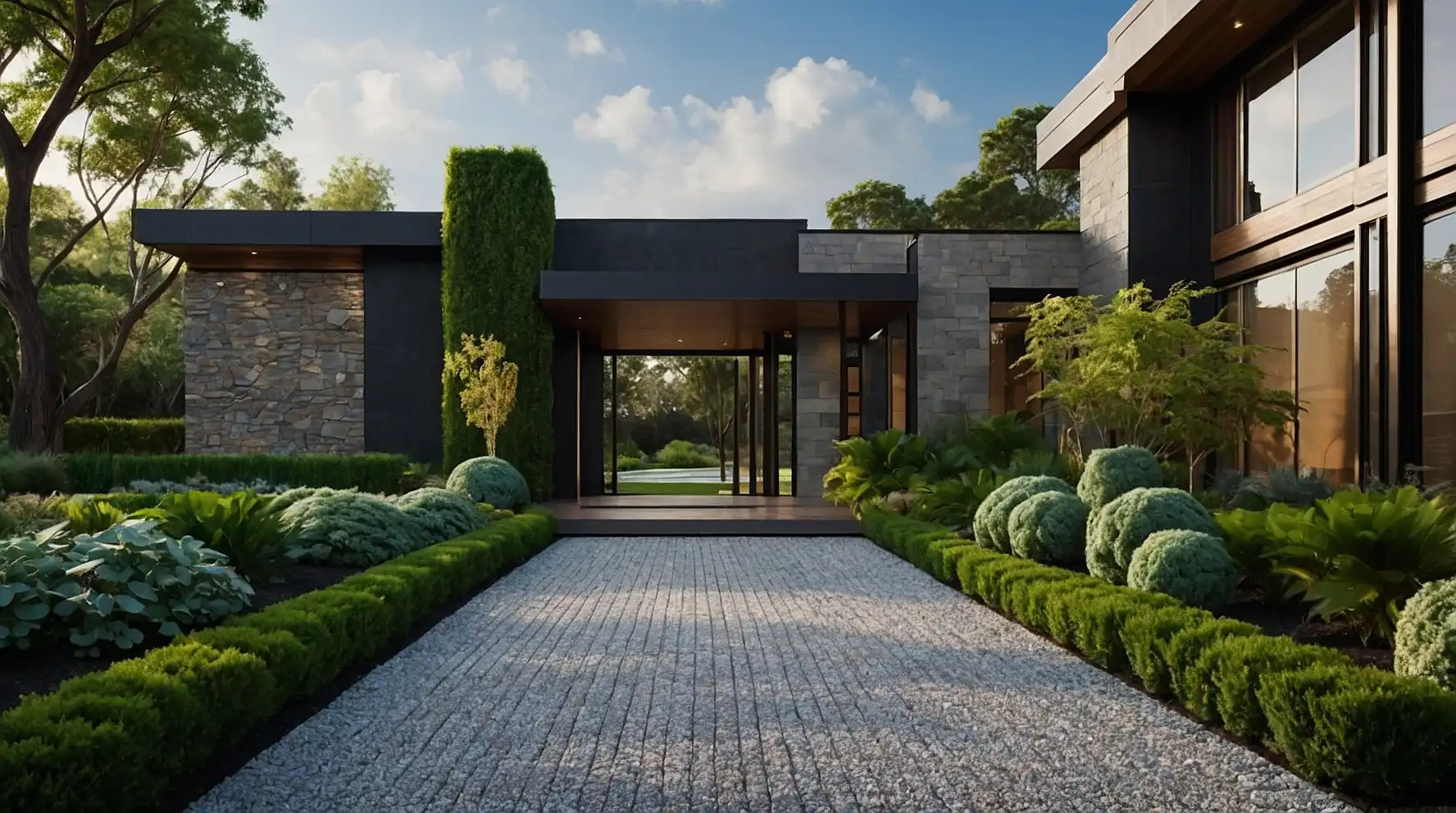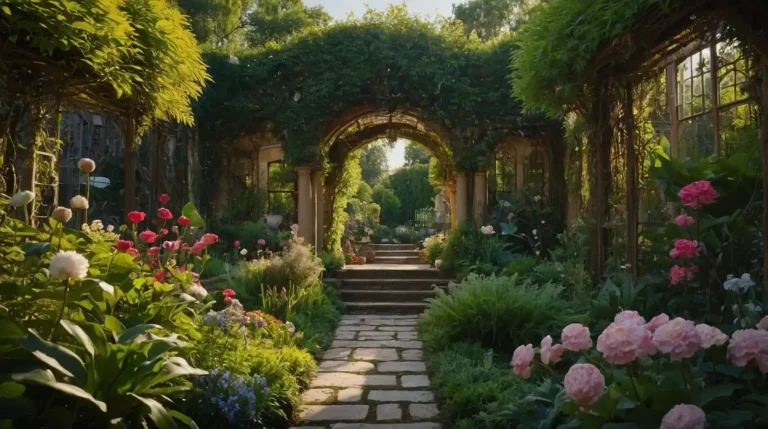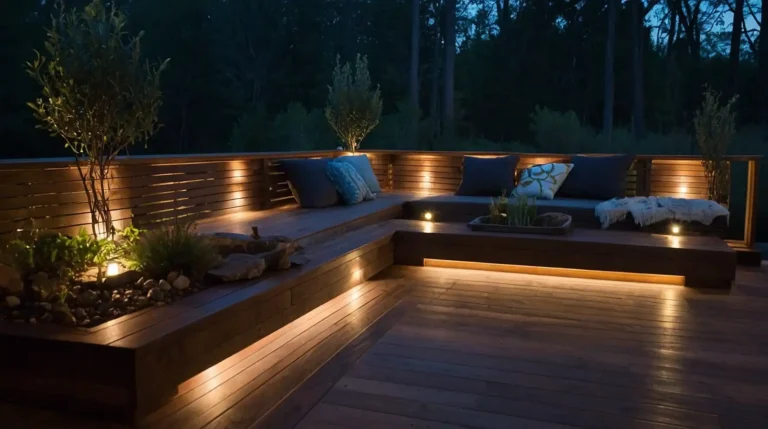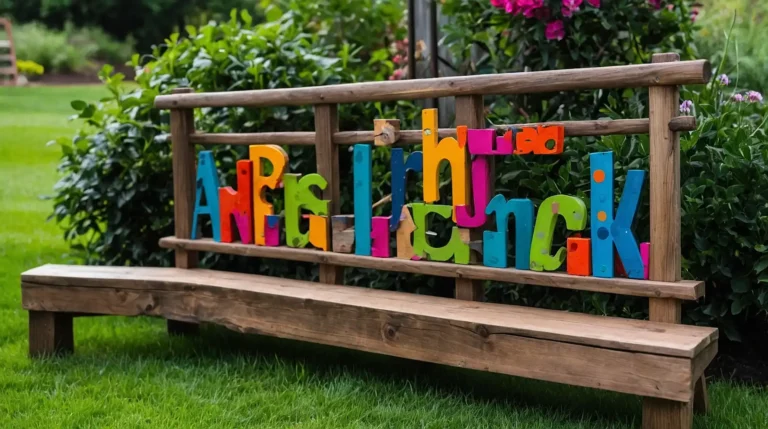27 Stunning Driveway Landscaping Ideas to Transform Your Home’s Entrance
Your driveway does more than just guide vehicles to your home—it creates the first impression of your property and sets the tone for your entire landscape design.
With thoughtful landscaping, you can transform this functional space into a beautiful, welcoming entrance.
Whether you have a long rural driveway or a short urban approach, strategic plantings and hardscape elements can dramatically enhance your curb appeal.
The right driveway landscaping balances aesthetics with practicality.
Ready to elevate your home’s entrance?
Explore these 27 driveway landscaping ideas that combine beauty, function, and personal style to create an unforgettable approach to your home.
1: Border with Lavender
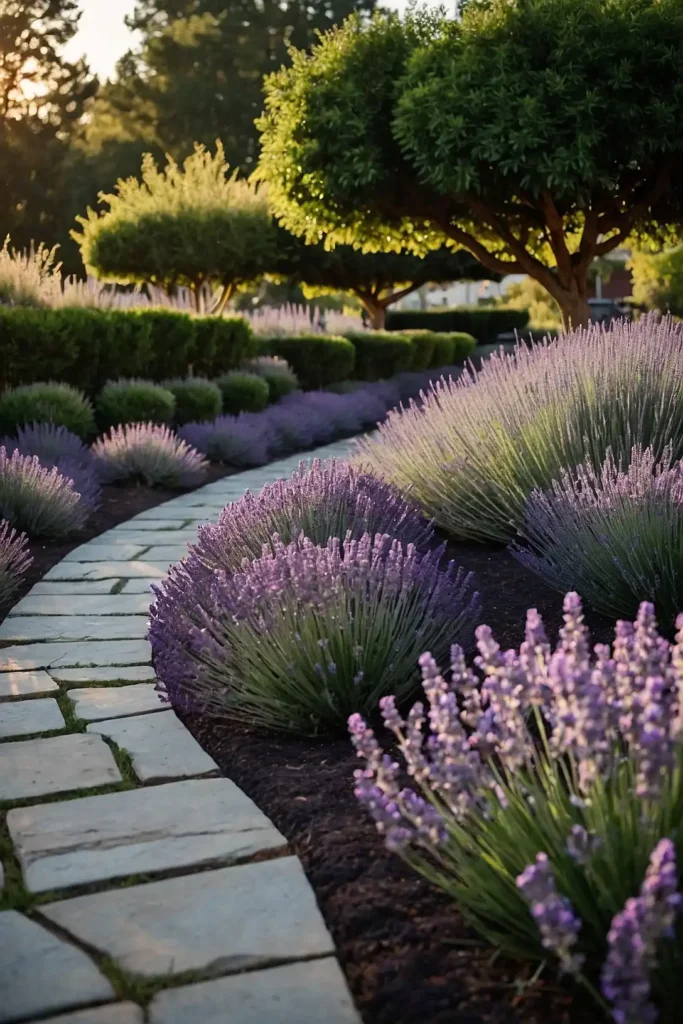
Line your driveway with fragrant lavender for a sensory experience that delights visitors before they even reach your door.
These purple blooms create a stunning visual edge while releasing their calming scent when brushed against.
Choose drought-resistant varieties like English or French lavender for low-maintenance appeal.
The silver-gray foliage looks attractive even when plants aren’t flowering.
For best results, plant lavender in well-draining soil and ensure it receives full sun to maintain its compact growth habit and abundant blooms.
2: Illuminated Pathway
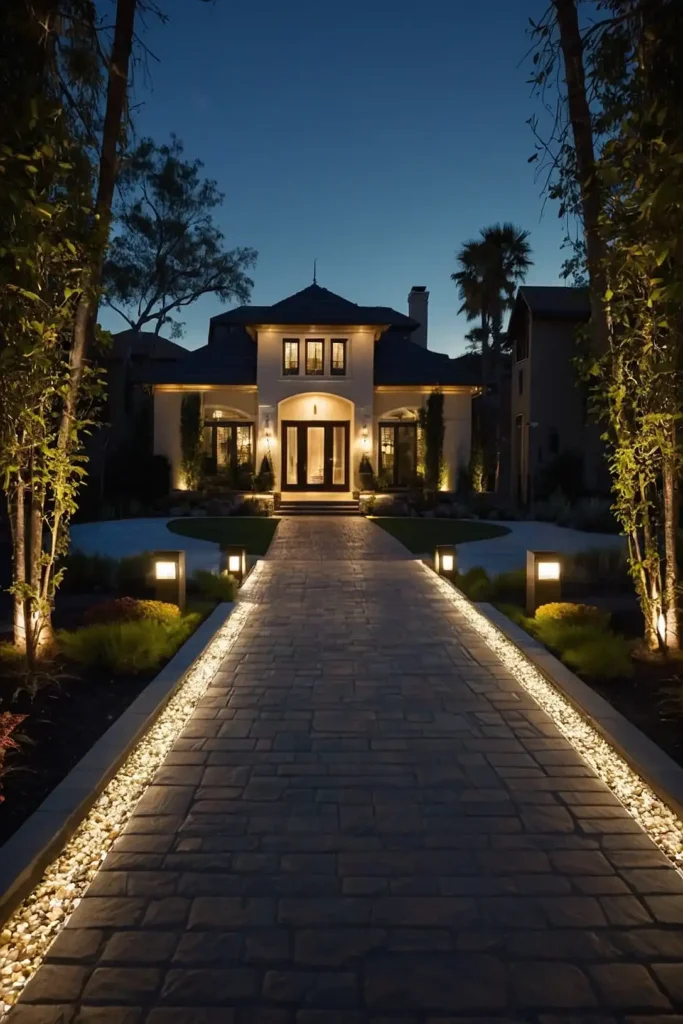
Install solar-powered or low-voltage LED lights along your driveway to create both safety and drama after dark.
These lights guide visitors safely while highlighting your landscape features.
Choose fixtures that complement your home’s architectural style—modern bollards for contemporary homes or lantern-style lights for traditional properties.
Space them evenly for consistent illumination.
Consider motion-activated options for added security or lights that change color for seasonal celebrations and special occasions.
3: Mixed Native Garden Border
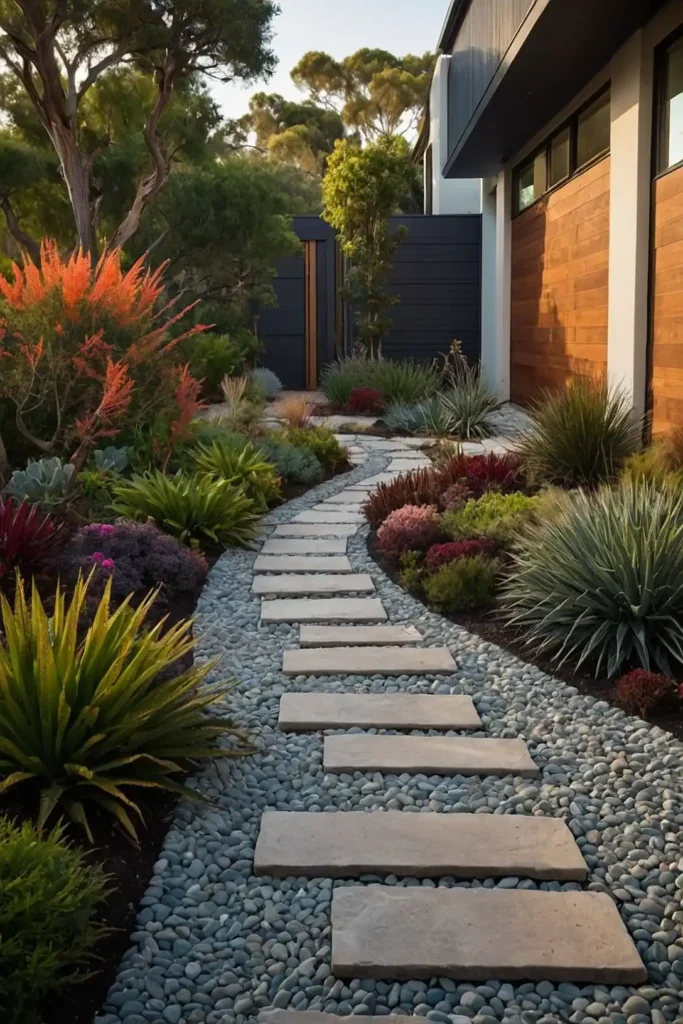
Create a sustainable, low-maintenance border using native plants adapted to your region’s specific conditions.
This eco-friendly approach reduces water usage while supporting local wildlife and pollinators.
Combine various heights, with taller plants like ornamental grasses or shrubs in the back and shorter flowering perennials in front.
This layered look provides year-round interest.
Research plants native to your specific area for best results—they’ll require less water, fertilizer, and overall care once established.
4: Ornamental Grass Groupings
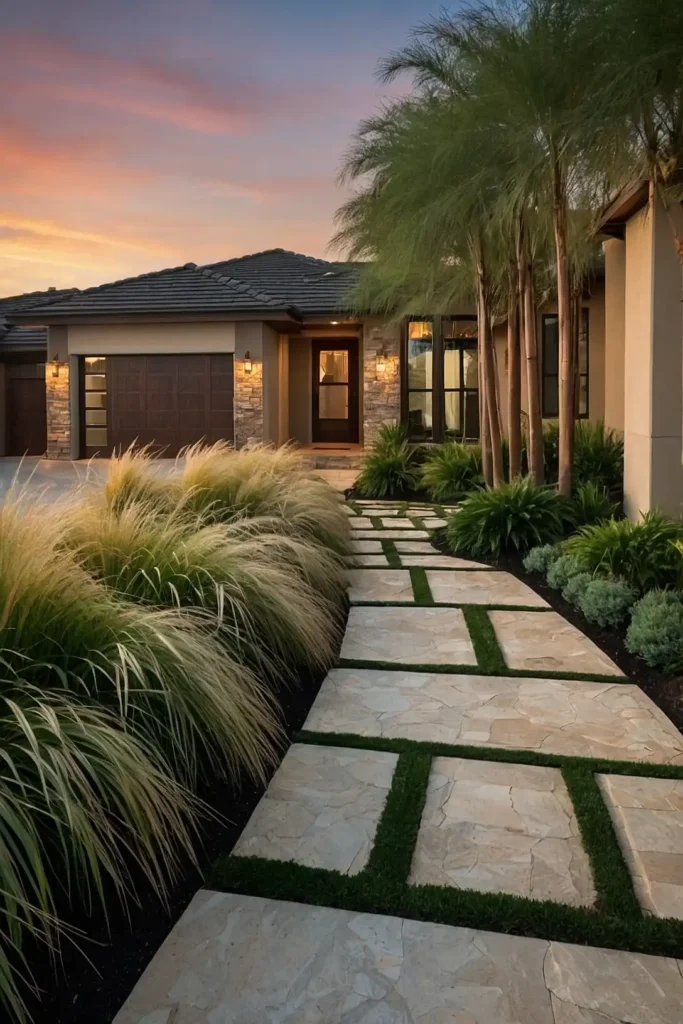
Plant strategically placed groupings of ornamental grasses to add movement, texture, and four-season interest to your driveway landscape.
These architectural plants look stunning when backlit by morning or evening sun.
Choose varieties like feather reed grass for vertical accent, blue fescue for compact borders, or dramatic maiden grass for larger spaces. Mix different types for varied heights and textures.
Most ornamental grasses require minimal maintenance—simply cut back in late winter before new growth begins in spring.
5: Belgian Block Edging
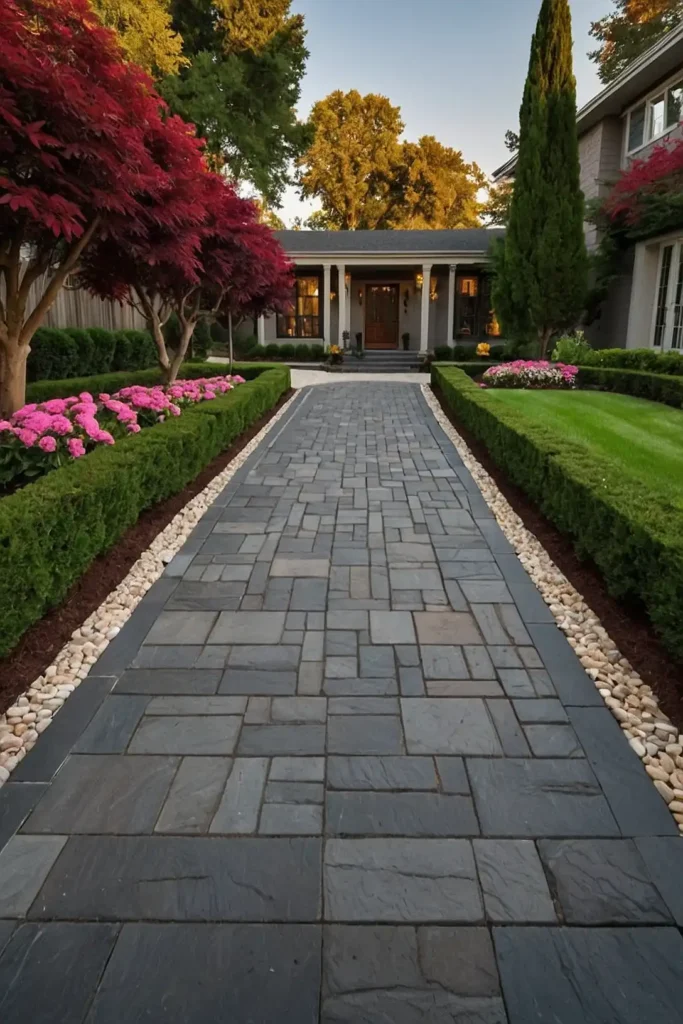
Install classic Belgian blocks (granite pavers) along your driveway edge to create a timeless, defined border that enhances any architectural style.
These durable stones bridge the gap between hardscape and landscape.
Set blocks into a compacted gravel base for stability, installing them either flush with the driveway for a subtle look or slightly raised to create a more pronounced edge.
The natural stone variations add character while preventing vehicles from straying onto your lawn or garden beds.
6: Flowering Tree Alee
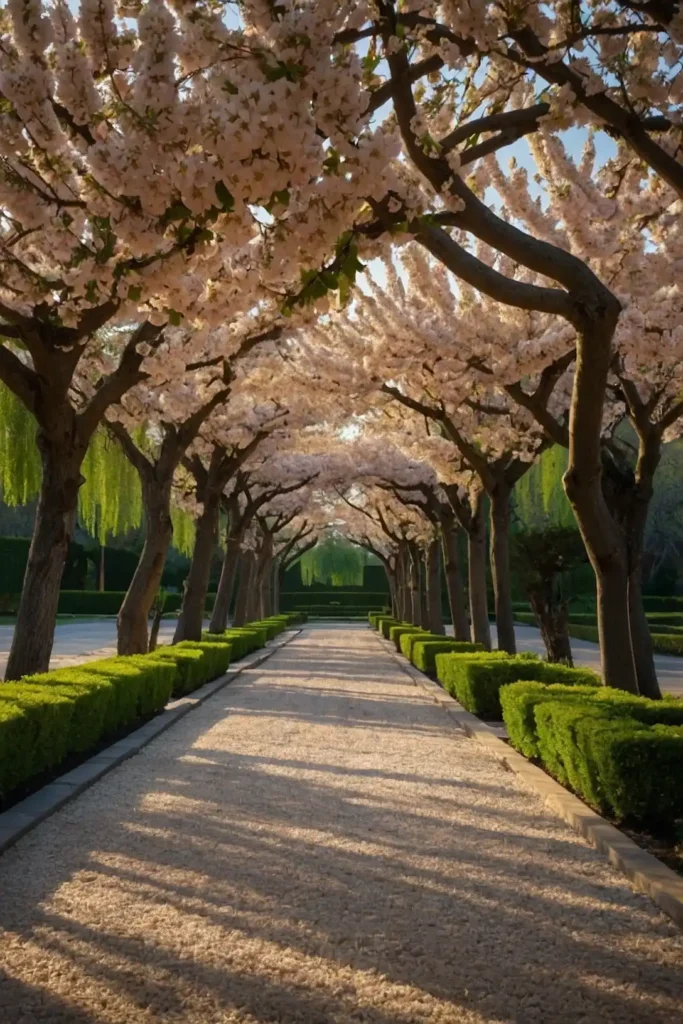
Plant matching flowering trees on both sides of a longer driveway to create a dramatic alee effect that changes with the seasons.
This formal design element adds estate-like elegance to any property.
Choose trees suited to your climate—flowering cherries, crabapples, or dogwoods for spring blooms, or crape myrtles for summer flowering in warmer regions. Space them consistently for the strongest visual impact.
For year-round appeal, select varieties with multiple seasons of interest, like spring flowers, summer berries, fall color, or interesting winter bark.
7: Tiered Retaining Walls
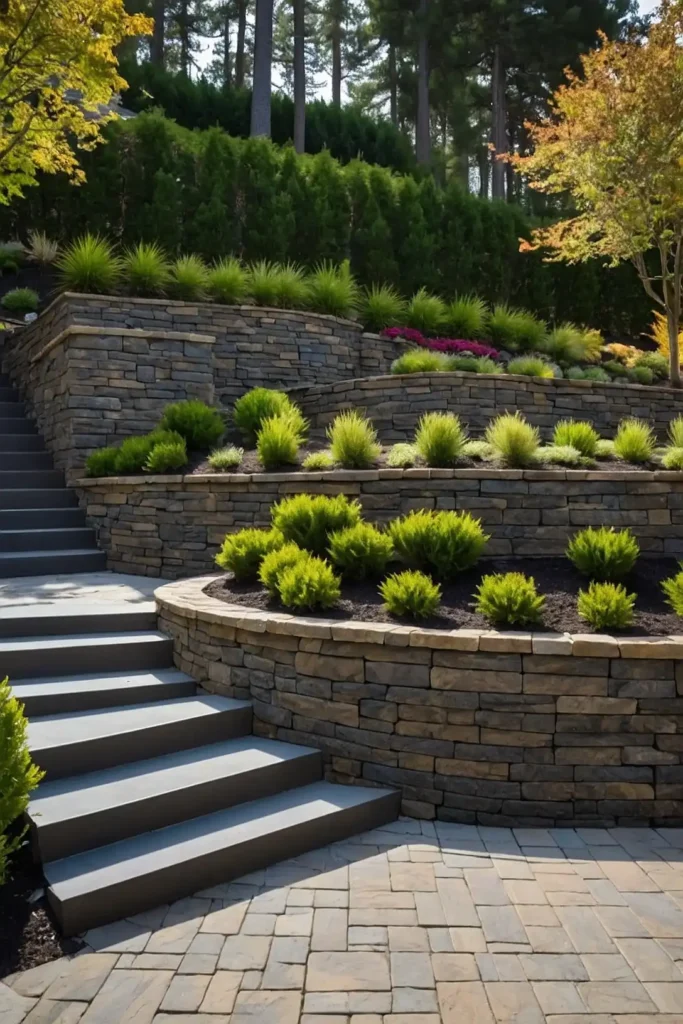
Build low retaining walls to create multilevel planting areas along sloped driveways.
This practical solution prevents erosion while offering expanded planting opportunities and visual interest.
Use materials that complement your home—natural stone for traditional properties, board-formed concrete for modern homes, or timber for rustic settings.
Each tier can feature different plant palettes.
Install adequate drainage behind walls and choose stones or blocks specifically designed for retaining wall construction to ensure long-term stability.
8: Sculptural Entrance Markers
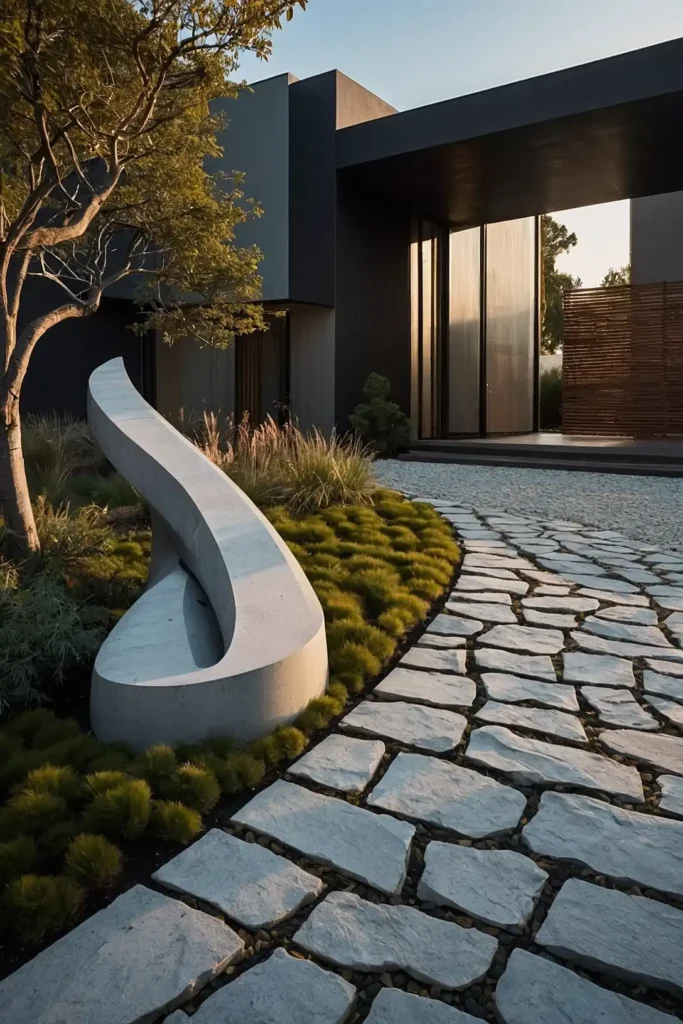
Place matching sculptural elements like stone columns, large containers, or ornamental gates at your driveway entrance to create a defined threshold and focal point.
These elements signal arrival and reflect your personal style.
Choose materials and designs that complement your home’s architecture—sleek metal for contemporary homes or natural stone for traditional styles.
Consider adding house numbers or lighting for practicality.
For maximum impact, keep these entrance markers proportional to your property size and home scale—larger for estate properties, more modest for urban settings.
9: Rain Garden Integration
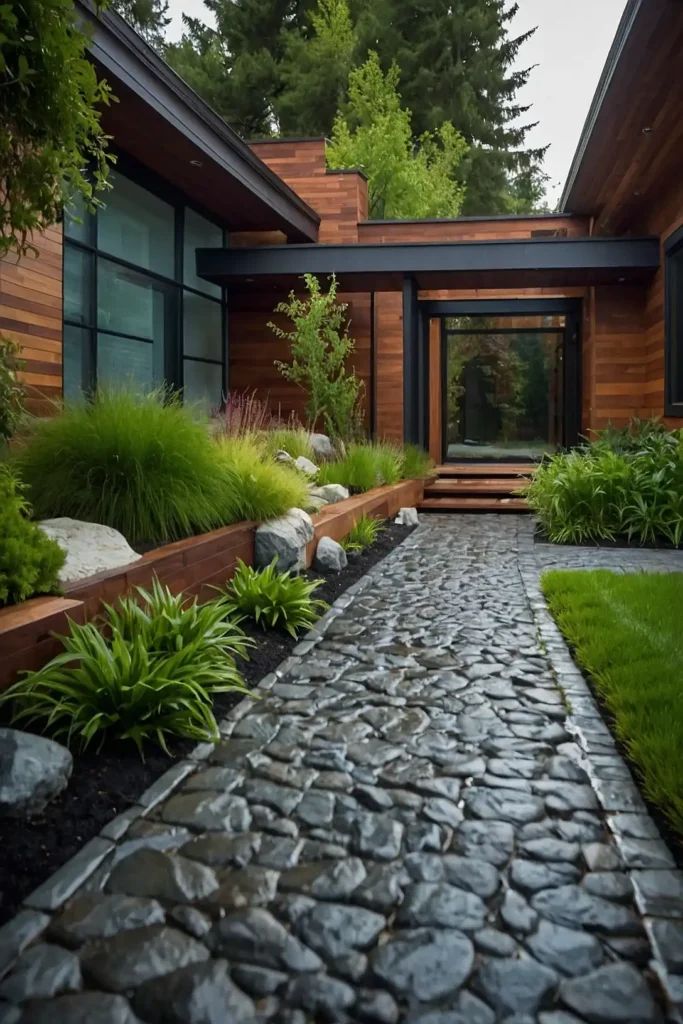
Transform a low-lying area near your driveway into a beautiful rain garden that captures and filters runoff.
This eco-friendly solution prevents pooling water and erosion while creating a lush planting opportunity.
Select water-loving native plants like iris, joe-pyre weed, or cardinal flower that thrive in occasionally wet conditions.
Add river rocks and boulders to slow water flow and add visual interest.
Design the garden with a slight depression to collect water, good drainage to prevent mosquitoes, and an overflow area for heavy rain events.
10: Boxwood Hedge Border
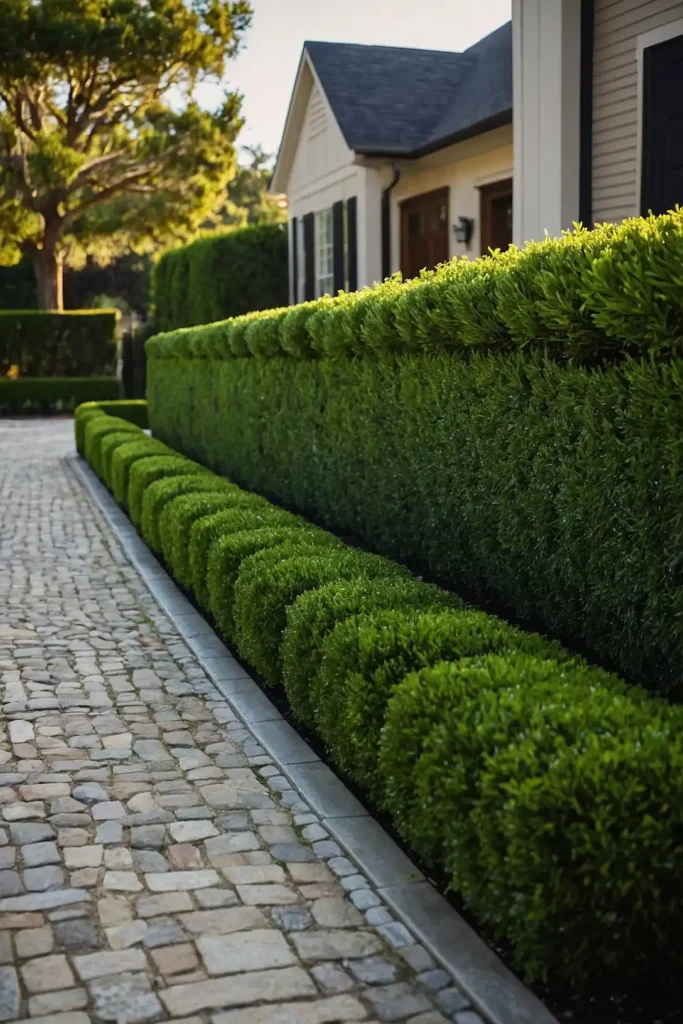
Plant a formal boxwood hedge along your driveway for a classic, structured look that remains green year-round.
This traditional approach brings timeless elegance to any property entrance.
Choose dwarf varieties like ‘Green Velvet’ or ‘Winter Gem’ for lower-maintenance options that require less frequent trimming.
Plant closely together for a solid, defined edge.
For best results, water regularly during establishment, add mulch to retain moisture, and shear annually to maintain the crisp, manicured appearance.
11: Seasonal Container Clusters
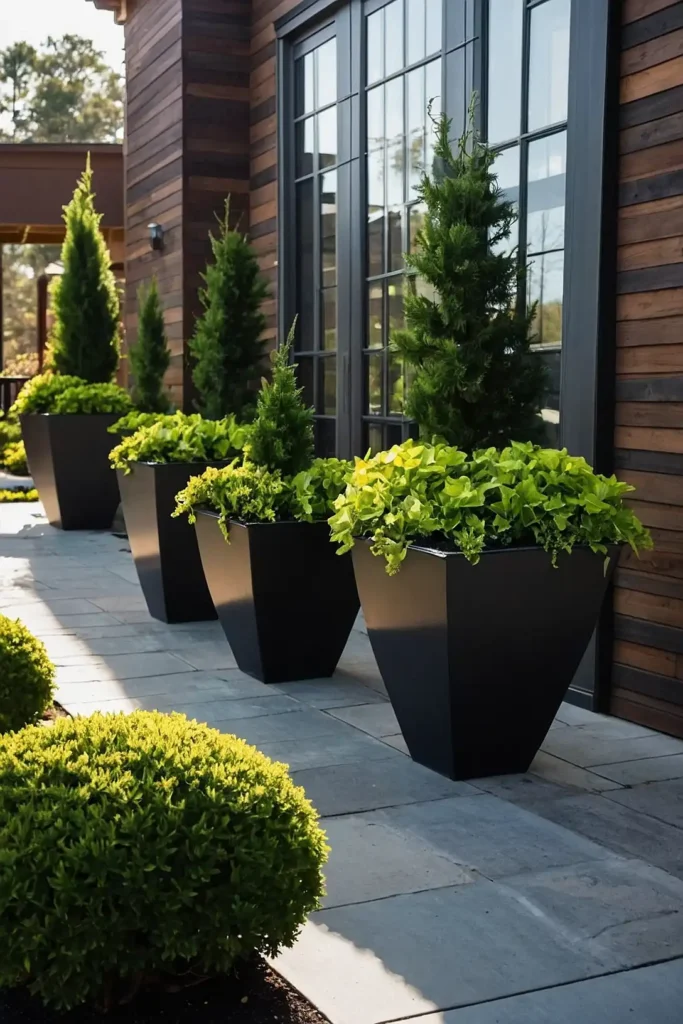
Place clusters of containers at strategic points along your driveway to create movable garden moments that you can change seasonally.
This flexible approach allows for continuous color and easy maintenance.
Use containers of varying heights and materials for dimensional interest. Group odd numbers (3 or 5) at key points like the entrance, curves, or near the house.
Change plantings seasonally—spring bulbs, summer annuals, fall mums, and winter evergreens—to maintain year-round appeal with minimal garden bed maintenance.
12: Meadow-Style Plantings
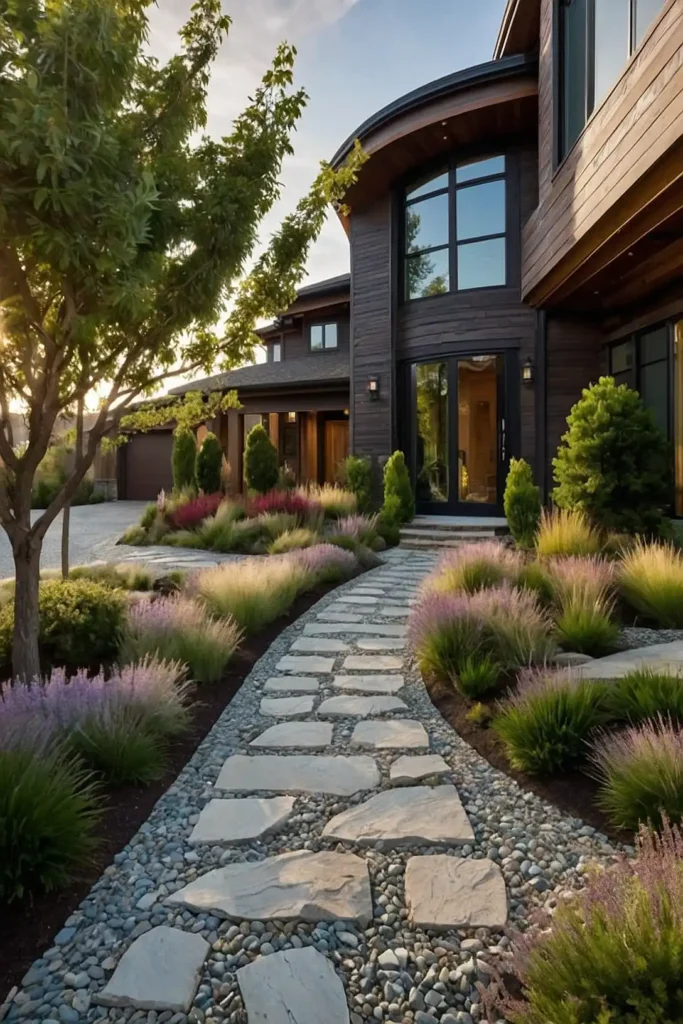
Create natural-looking meadow areas alongside rural or longer driveways using wildflowers and native grasses.
This low-maintenance approach provides habitat for beneficial insects and birds.
Choose a mix of perennial flowers that bloom in different seasons—coneflowers, black-eyed Susan’s, and asters provide months of changing color.
Add ornamental grasses for structure and winter interest.
Prepare the area thoroughly before planting to eliminate weeds, and plan for annual maintenance including cutting back in late winter or early spring.
13: Stone Steppers in Groundcover
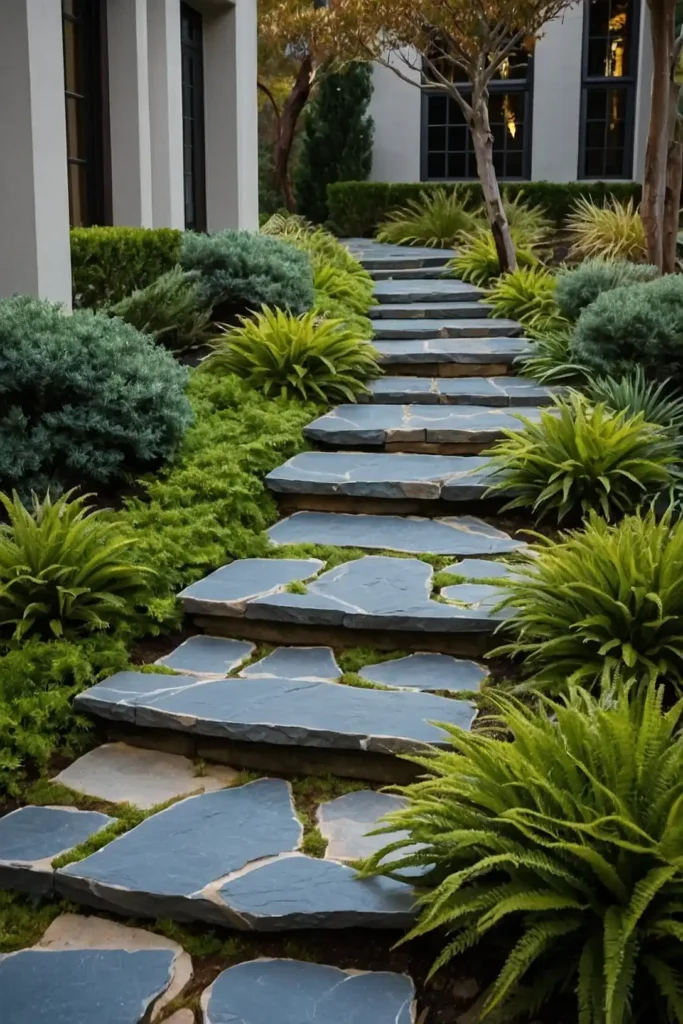
Embed large flat stepping stones within low-growing groundcover alongside your driveway to create practical access points that blend naturally with your landscape.
This combination unites functionality with aesthetics.
Choose durable groundcovers like creeping thyme, sedum, or ajuga that can handle occasional foot traffic.
The contrast between stone and living material adds visual interest.
Space stepping stones at a natural walking stride length, setting them on a stable base slightly above soil level to prevent shifting or sinking over time.
14: Espalier Fruit Trees
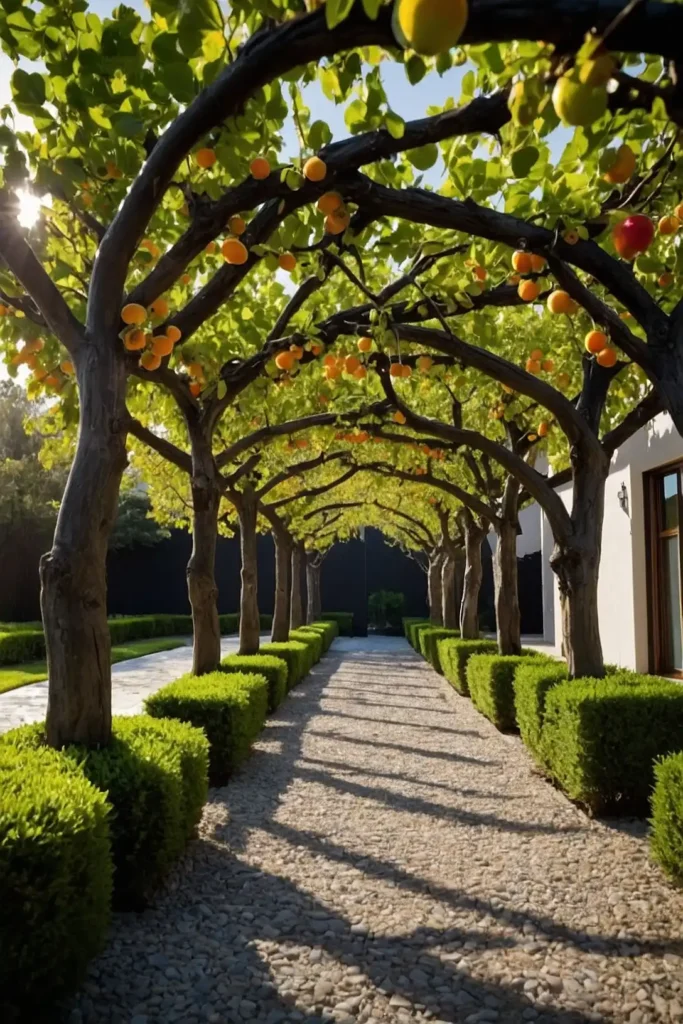
Train fruit trees flat against a wall or fence alongside your driveway using the espalier technique.
This space-saving method creates a stunning architectural element while producing edible fruit.
Select varieties suited to espalier—apples and pears work particularly well.
The formal patterns of branches create winter interest, while spring blossoms and summer fruit add seasonal appeal.
Install strong support systems using wire and sturdy posts, and plan for regular pruning to maintain the distinctive horizontal branching pattern.
15: Driveway Island Garden
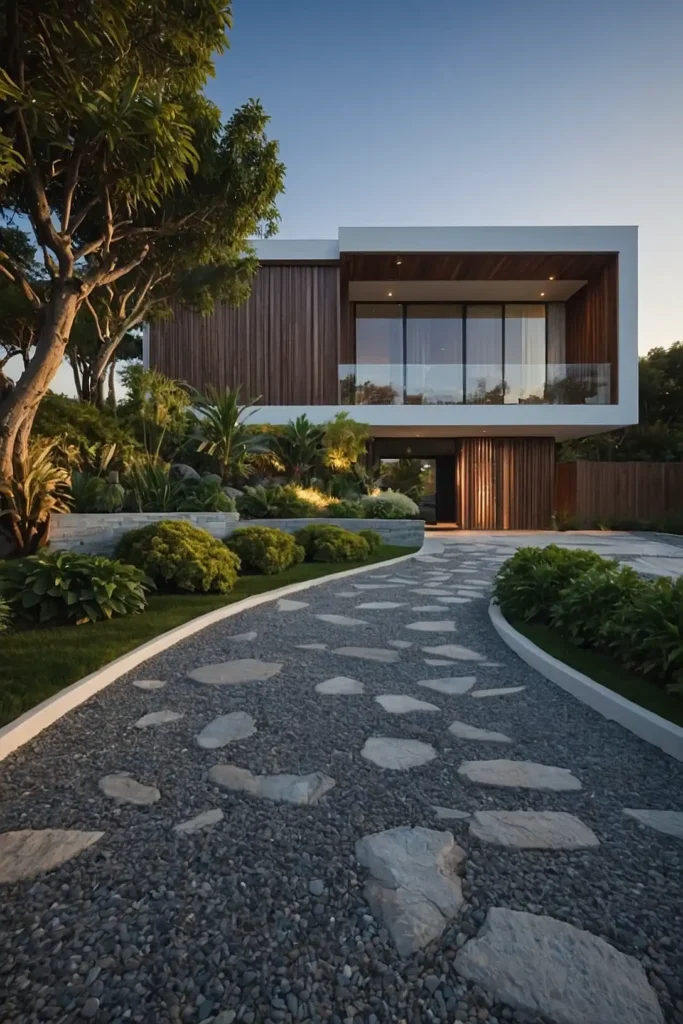
Create a planted island in the middle of a circular driveway or wide entrance area to add significant planting space and a focal point.
This design element adds estate-like character to your approach.
Plant a specimen tree or large shrub as a centerpiece, surrounded by lower-growing perennials or groundcovers for a complete composition.
Consider adding landscape lighting to highlight this feature at night.
Ensure the island is sized appropriately for vehicle turning radius, and consider adding a small curb to protect plants from tire damage.
16: Cottage Garden Border
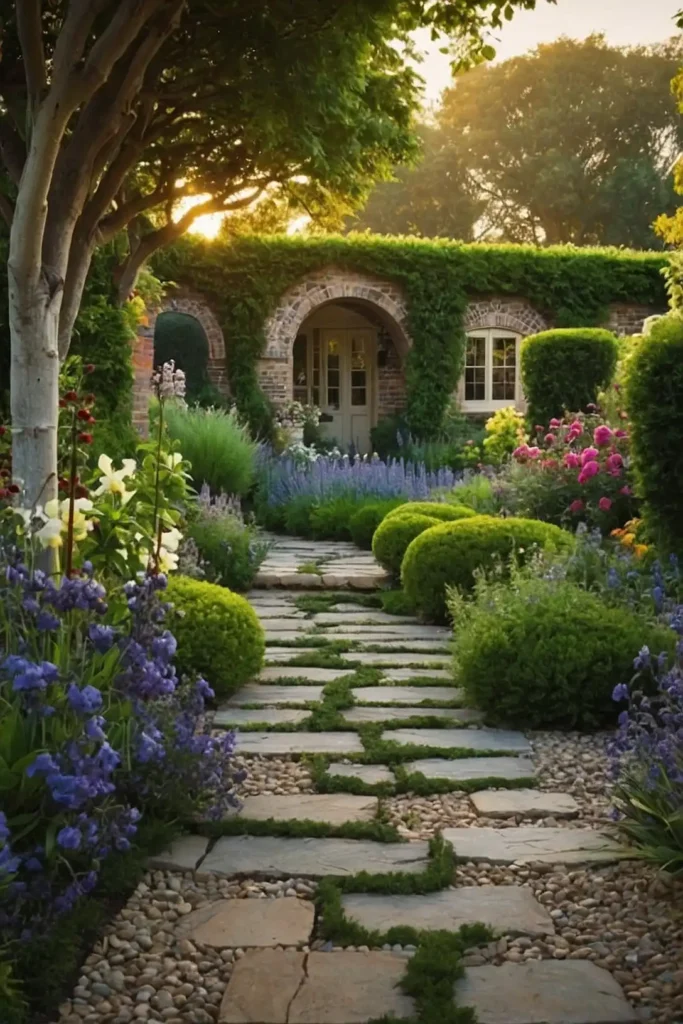
Plant a lush, informal cottage garden alongside your driveway with a mix of flowering perennials, soft grasses, and flowering shrubs.
This romantic approach creates a welcome that changes throughout the seasons.
Layer plants with taller varieties in back and shorter ones in front, allowing them to spill slightly over the driveway edge for a soft, established look.
Include classics like roses, lavender, catmint, and coneflowers.
Incorporate plants with varied blooming periods to ensure continuous color from spring through fall, with structural elements for winter interest.
17: Zen Garden Elements
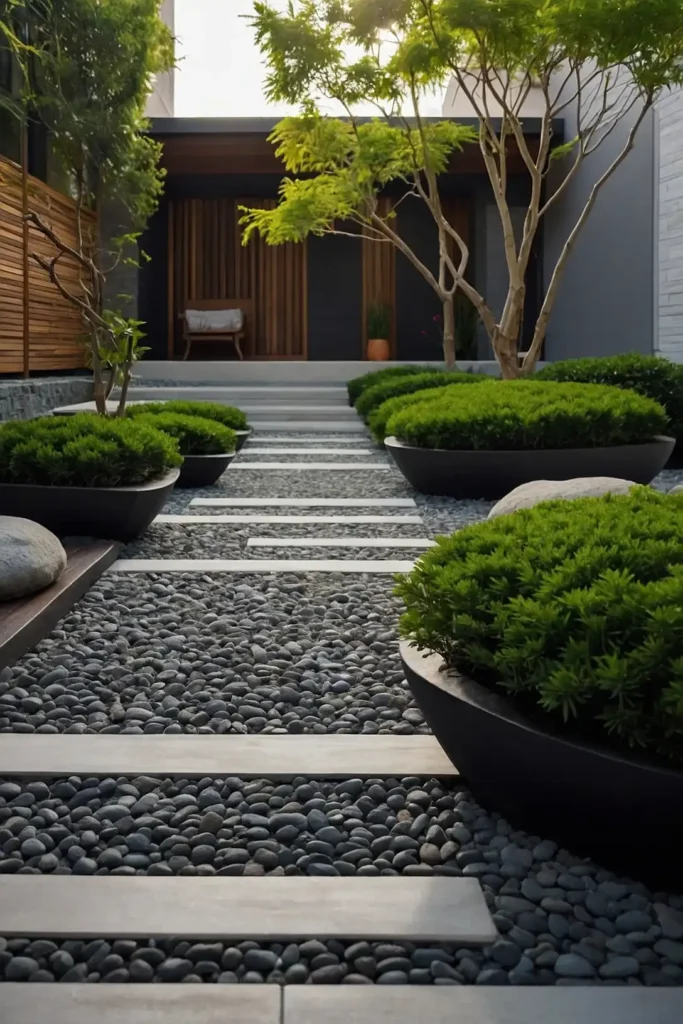
Create a minimalist border using carefully placed boulders, gravel, and specimen plants inspired by Japanese garden design.
This approach brings tranquility and order to your driveway entrance.
Select weathered stones of varying sizes and arrange them asymmetrically among fine gravel or crushed stone.
Add sparse plantings of architectural species like Japanese maple, pine, or ornamental grasses.
Use a steel or stone edging to contain the gravel and create clean lines between your driveway surface and this contemplative landscape feature.
18: Living Fence
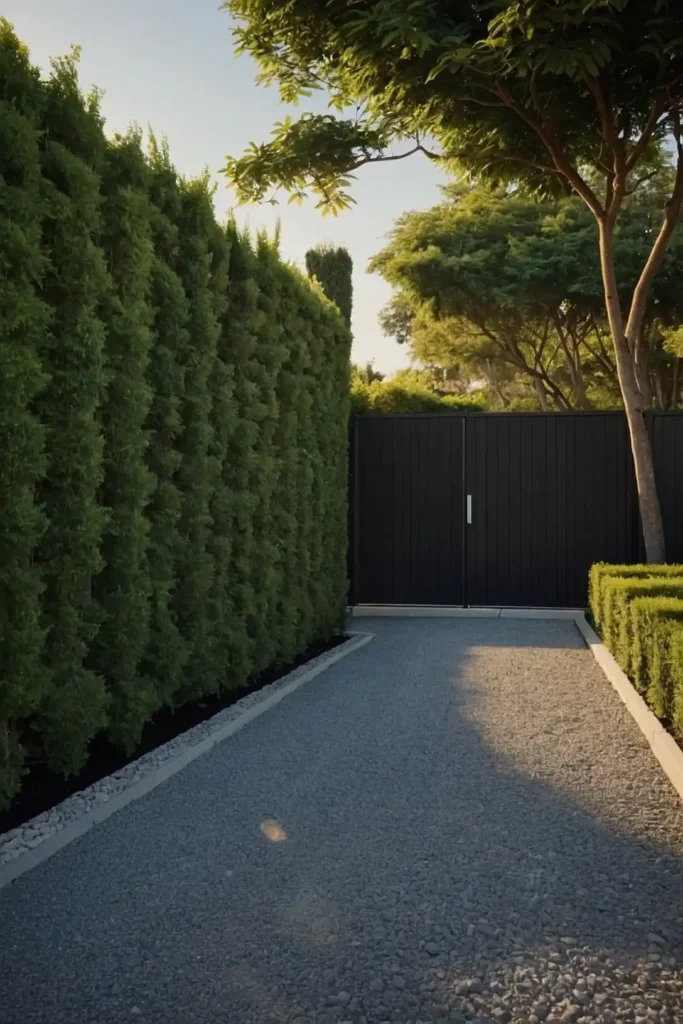
Plant a mixed hedgerow of flowering shrubs and small trees to create a living fence that defines your driveway while providing privacy and wildlife habitat.
This natural barrier evolves beautifully over time.
Combine deciduous and evergreen species for year-round screening—viburnums, lilacs, hollies, and serviceberries offer flowers, berries, and seasonal color.
Allow some natural form rather than formal shearing.
For maximum ecological benefit, include native berry-producing shrubs that provide food for birds and create habitat connections within your landscape.
19: Ornamental Herb Border
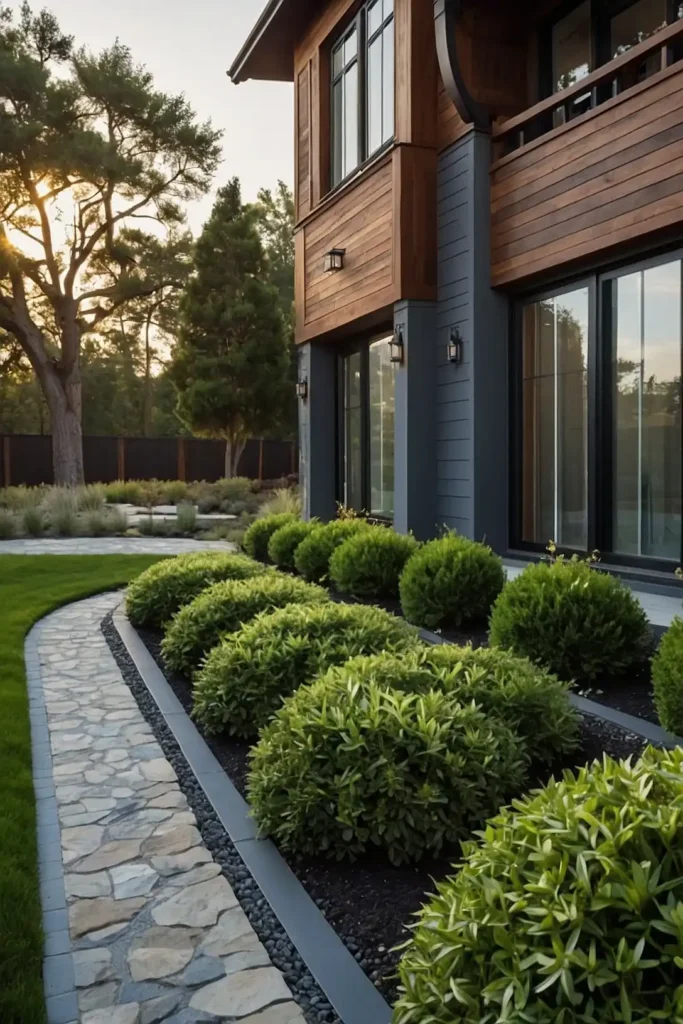
Line your driveway with a fragrant, practical herb garden that engages the senses while providing culinary ingredients.
This productive border combines beauty with function.
Choose ornamental herb varieties with attractive flowers and foliage—purple sage, golden oregano, and blooming thyme create a tapestry of texture and color.
Taller herbs like rosemary or lavender can anchor corners.
Plan for easy access points so you can harvest regularly, and include stepping stones or a narrow path alongside the driveway for maintenance without compacting soil.
20: Drifts of Ornamental Onions
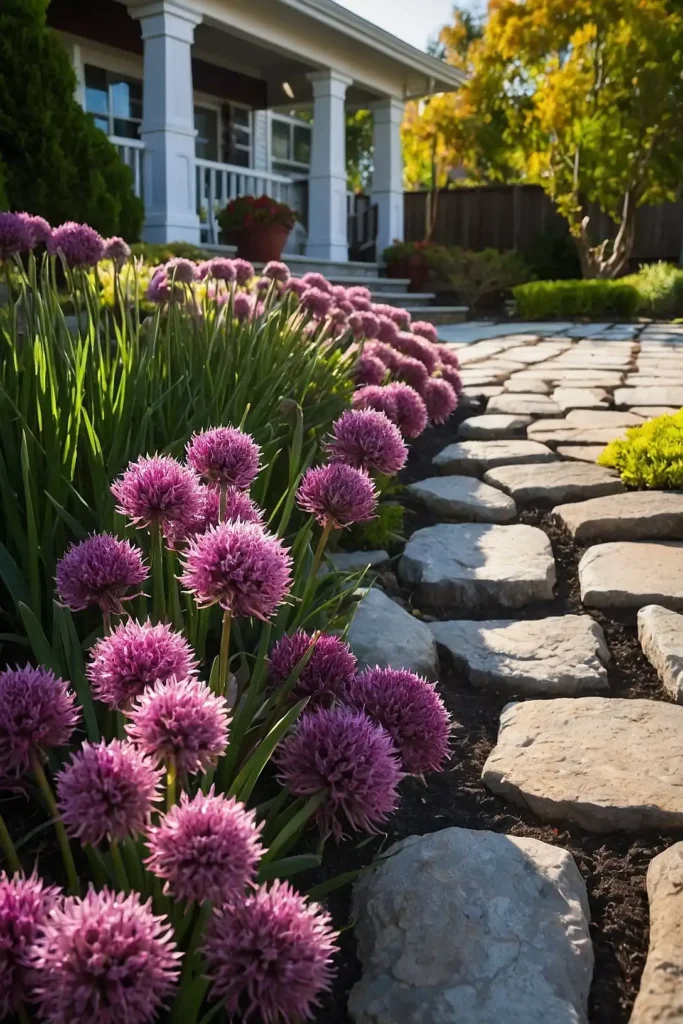
Plant sweeping drifts of alliums (ornamental onions) along your driveway for dramatic spring and early summer impact.
Their spherical blooms create whimsical, architectural elements on slender stalks.
Mix varieties with different bloom times, sizes, and colors—from massive ‘Globemaster’ to smaller ‘Purple Sensation’—for extended seasonal interest.
The seed heads remain attractive long after flowers fade.
Plant bulbs in fall in well-draining soil, and consider interplanting with perennials that will grow up to hide fading foliage as summer progresses.
21: Succulent Garden Display
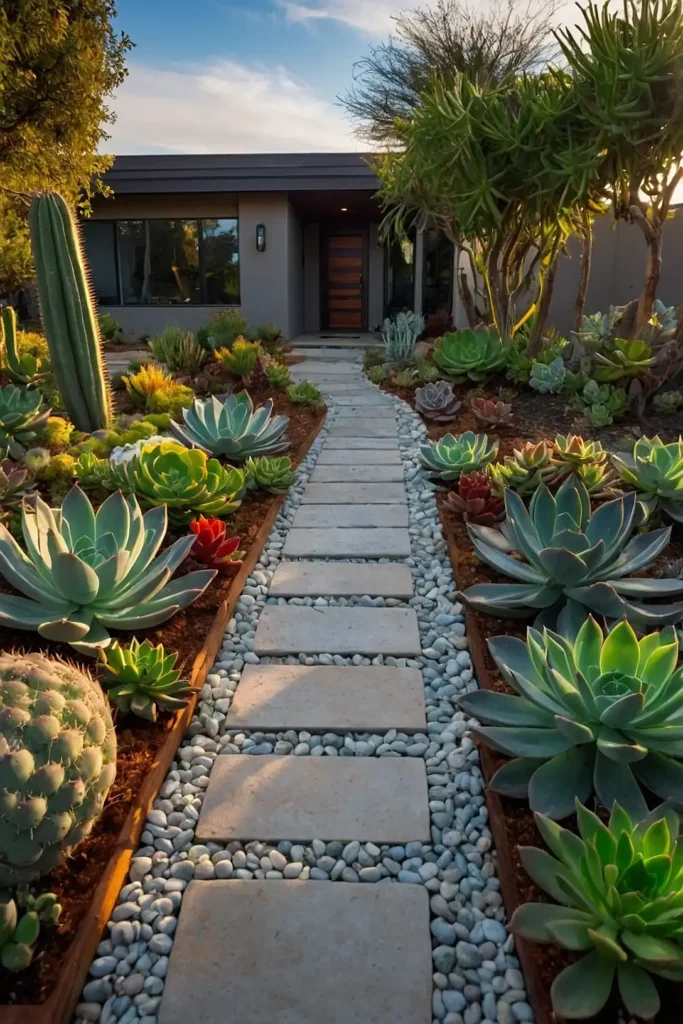
Create a low-maintenance, drought-resistant border using architectural succulents and decorative gravel.
This striking combination works especially well in hot, dry climates with water restrictions.
Choose cold-hardy varieties appropriate for your region—sedums, semper-vinum’s, and yuccas offer year-round structure with seasonal flowers.
Add larger specimen plants like agave for dramatic focal points.
Ensure excellent drainage by amending soil with grit or sand, and install landscape fabric under decorative stone to minimize weed growth for truly low-maintenance appeal.
22: Four-Season Berry Border
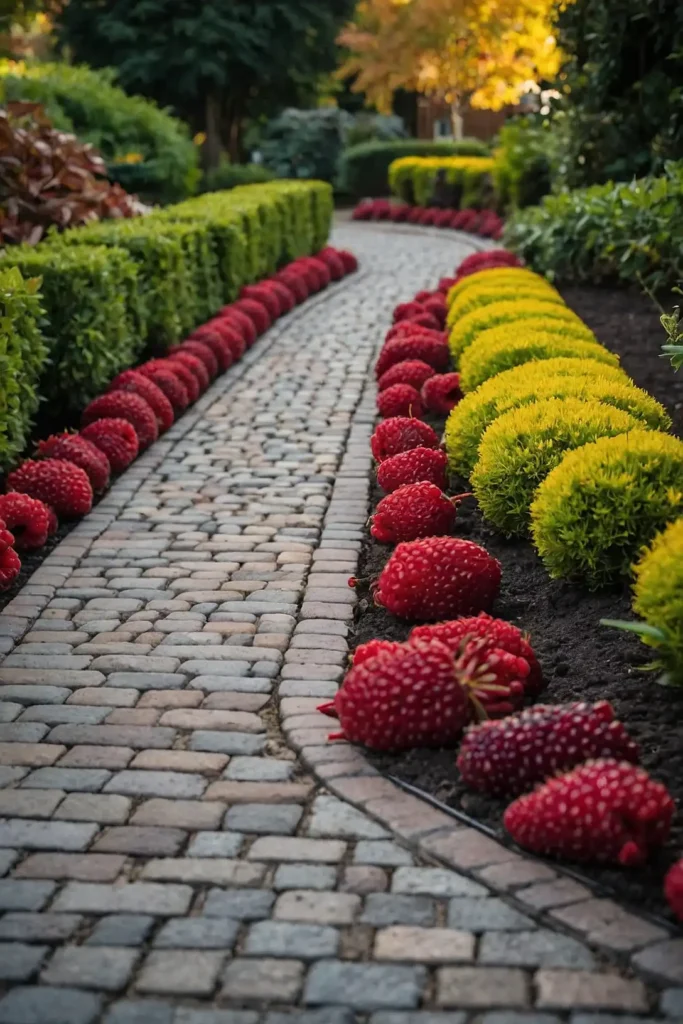
Plant a mixture of berry-producing shrubs along your driveway to create wildlife habitat and year-round visual interest.
The changing seasons bring flowers, fruit, and fall color.
Include diverse native species like serviceberry, chokeberry, and winterberry holly that produce berries at different times.
These attract birds and other wildlife, bringing your landscape to life.
For maximum visual impact, plant in groups of three or five rather than single specimens, creating drifts of color when fruiting or flowering.
23: Topiary Accents
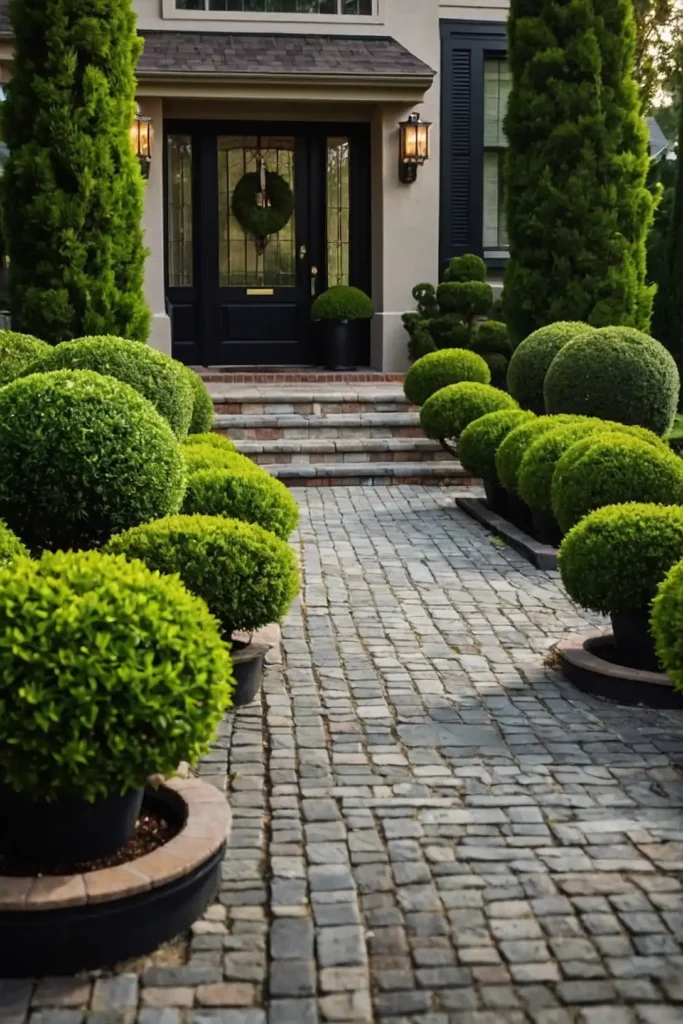
Place formally pruned topiary specimens at key points along your driveway to add architectural elements and year-round structure.
These living sculptures create instant character and formality.
Choose evergreens like boxwood, yew, or privet that maintain dense foliage and respond well to shaping.
Start with simple forms like spheres or cones for easier maintenance.
For balanced design, use matching pairs to mark transition points or entryways, or place single specimens as focal points at curves or corners.
24: Prairie-Style Planting
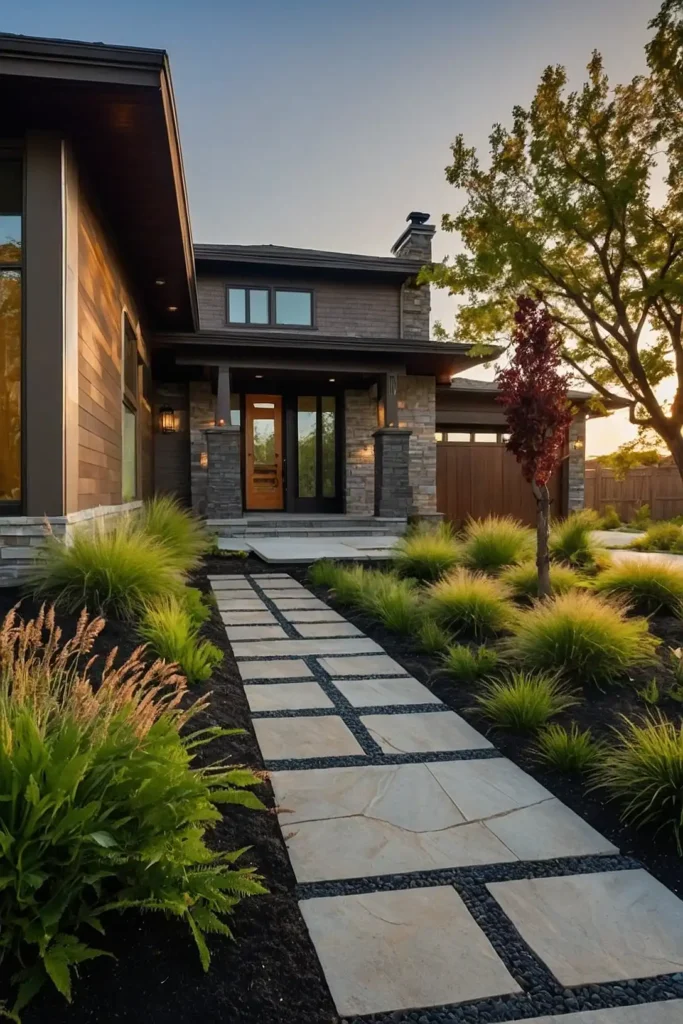
Create a naturalistic border inspired by prairie ecosystems, using native grasses and wildflowers that provide habitat and four-season interest.
This approach brings ecological value to your entrance landscape.
Combine tall grasses like switchgrass or little bluestem with flowering perennials such as coneflowers, goldenrod, and asters.
Plant in drifts and allow natural intermingling for an authentic look.
This style looks best when given adequate space—perfect for longer rural driveways where a more manicured approach would require excessive maintenance.
25: Terraced Rock Garden
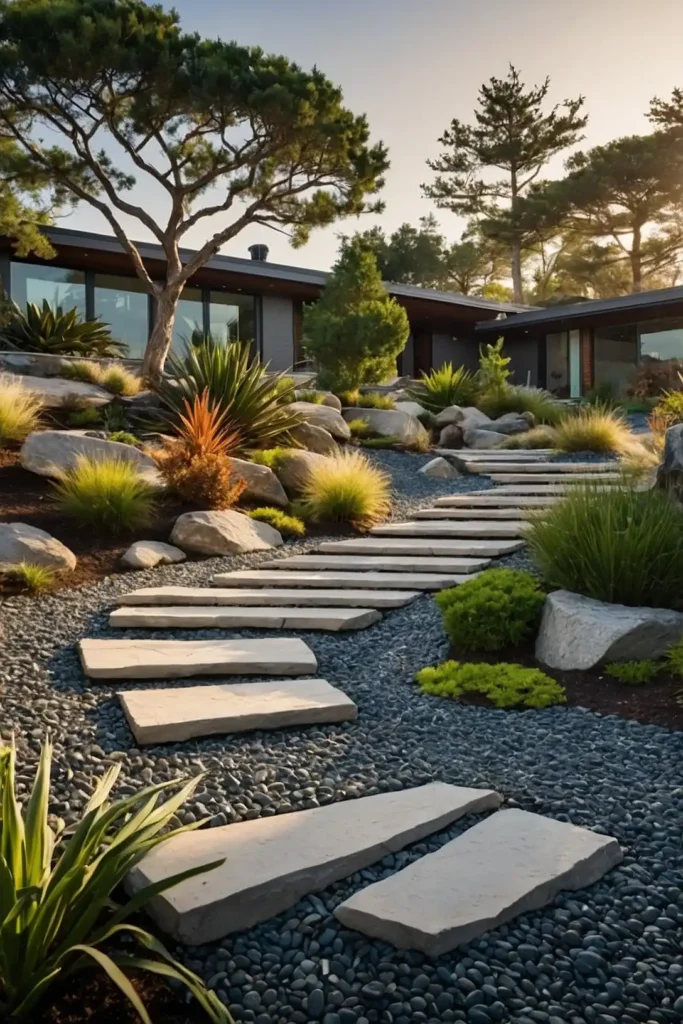
Transform a sloped driveway side into a rock garden with cascading plants spilling over low terraces.
This solution addresses challenging topography while creating visual interest.
Use locally sourced stone to build shallow terraces filled with well-draining soil.
Plant rock garden specialists like sedums, small conifers, and alpine perennials that thrive in these conditions.
For best results, position larger, dramatic rocks partially buried to appear natural, and ensure good drainage to prevent winter damage to drought-adapted plants.
26: Evergreen Framework
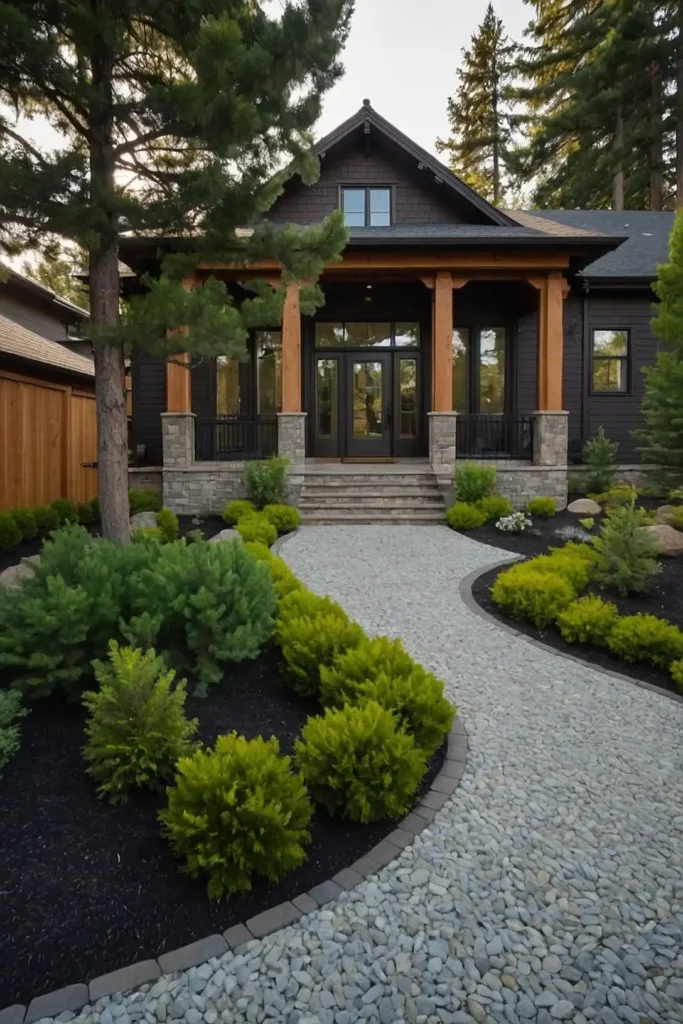
Plant a structured arrangement of diverse evergreens to create year-round form and color along your driveway.
This approach ensures your entrance looks polished even in winter months.
Mix different textures and shapes—upright junipers, mounding arborvitae, and spreading yews—to create dimensional interest. Incorporate varieties with different foliage colors from blue-green to gold.
Space plants with mature size in mind, allowing room for growth while maintaining distinct forms rather than creating a solid hedge effect.
27: Butterfly Garden Border
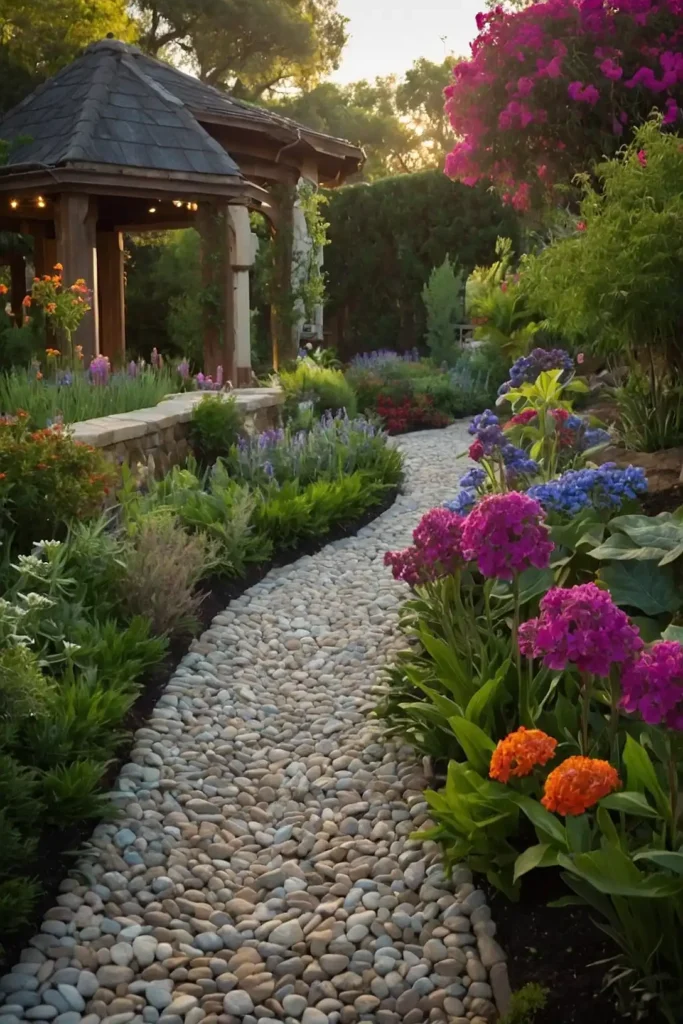
Transform your driveway border into a habitat garden specifically designed to attract butterflies and pollinators.
This eco-friendly approach brings movement, color, and life to your entrance.
Include both nectar plants for adult butterflies (coneflowers, zinnia, butterfly bush) and host plants for caterpillars (milkweed, parsley, aster).
This diverse planting supports the complete lifecycle.
Add a small water source like a shallow dish with stones for butterflies to drink from, and limit pesticide use to protect these beneficial insects.
Conclusion
Your driveway landscaping creates the crucial first impression of your home.
With these 27 ideas as inspiration, you can transform this functional space into a beautiful, welcoming entrance that reflects your personal style and enhances your entire property.

